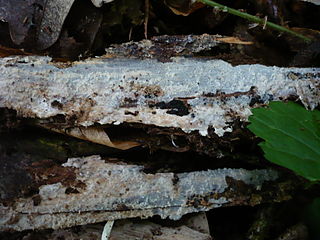Related Research Articles

The Clavulinaceae are a family of fungi in the order Cantharellales. The family is not well defined, but currently comprises species of clavarioid fungi as well as some corticioid fungi. These species are nutritionally diverse, some being ectomycorrhizal, others wood-rotting saprotrophs, others lichenized, and yet others lichenicolous.

Agaricomycetidae is a subclass of fungi, in the division Basidiomycota. The name Agaricomycetidae had previously been named by Marcel Locquin in 1984, but his publication did not contain a Latin diagnosis and it is therefore invalid under the International Code of Nomenclature for algae, fungi, and plants. It was subsequently validly published by Erast Parmasto in 1986.
Abundisporus is a small genus of poroid fungi currently with seven recognized species. They differ from other polypores in having coloured rather than hyaline spores.

Phanerochaete is a genus of crust fungi in the family Phanerochaetaceae.

The Meruliaceae are a family of fungi in the order Polyporales. According to a 2008 estimate, the family contains 47 genera and 420 species. As of April 2018, Index Fungorum accepts 645 species in the family.

The Phanerochaetaceae are a family of mostly crust fungi in the order Polyporales.

Erast Parmasto was a noted Estonian mycologist, bioscientist and botanist and onetime director of the Estonian Institute of Zoology and Botany.

The Botryobasidiaceae are a family of fungi in the order Cantharellales. The family contains a group of corticioid fungi that form thin, web-like basidiocarps. Some species form asexual anamorphs producing chlamydospores. All are believed to be wood-rotting or litter-rotting saprotrophs. None is known to be of any economic importance.

Byssomerulius is a widely distributed genus of crust fungi.

Trichaptum is a genus of poroid fungi. The genus was circumscribed by American mycologist William Alphonso Murrill in 1904. Formerly classified in the family Polyporaceae, several molecular studies have shown that the genus belongs to the order Hymenochaetales.

Resinicium is a genus of crust fungi of uncertain placement in the class Agaricomycetes. The genus was circumscribed by Estonian mycologist Erast Parmasto in 1968.

Phlebia is a genus of mostly crust fungi in the family Meruliaceae. The genus has a widespread distribution. Phlebia species cause white rot.

Mycoacia is a genus of toothed crust fungi in the family Meruliaceae. It was circumscribed by Dutch mycologist Marinus Anton Donk in 1931.

Cerocorticium is a genus of seven species of crust fungi in the family Meruliaceae.

Hypochnicium is a genus of corticioid fungi in the family Meruliaceae. The genus was circumscribed by mycologist John Eriksson in 1958.
Dictyonema is a genus of mainly tropical basidiolichens in the family Hygrophoraceae.

Fibrodontia is a genus of fungi in the Hydnodontaceae family. The widely distributed genus was circumscribed by Erast Parmasto in 1968. According to Index Fungorum, the type species Fibrodontia gossypina is currently known as Hyphodontia gossypina (Parmasto) Hjortstam.

Xenasma is a genus of corticioid fungi in the order Polyporales. It was circumscribed by mycologist Marinus Anton Donk in 1957.

Liiva-Putla Nature Reserve is a nature reserve situated on Saaremaa island in western Estonia, in Saare County.
Lilaceophlebia is a genus of three species of crust fungi in the family Meruliaceae. The genus was first proposed by Erast Parmasto in 1968 as a section of the genus Phlebia. Viacheslav Spirin and Ivan Zmitrovich elevated the taxon to generic status in 2004.
References
- ↑ Parmasto E. (2000). "New taxa and new combinations in hymenochaetoid fungi (Hymenomycetes)". Folia Cryptogamica Estonica. 37: 55–66.